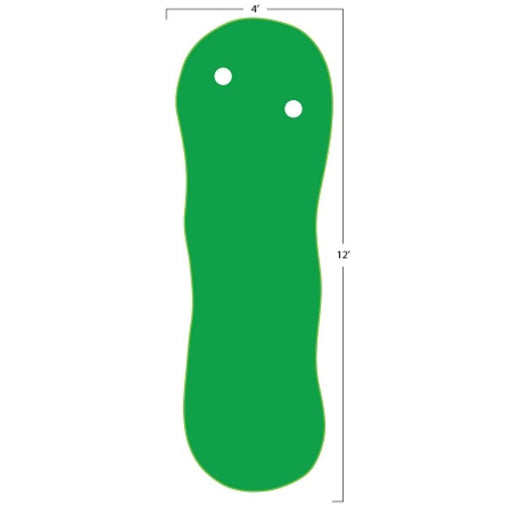
The Technology Behind Golf Simulator Impact Screens
Golf simulators have revolutionized the way enthusiasts practice and enjoy the game. At the heart of this transformative experience lies a key component—the impact screen. Beyond its seemingly simple role of catching golf balls, these screens are a marvel of technology that brings the virtual fairways to life. In this blog post, let's embark on a journey to explore the intricate technology that powers golf simulator impact screens, turning swings into digital strokes with precision and realism.
1. Display Materials: Where Realism Meets Durability
The foundation of any golf simulator impact screen is its display material. Modern screens utilize high-quality materials that strike a delicate balance between realism and durability. Polyethylene, polyester, or nylon-based fabrics are commonly employed, offering a surface that accurately mimics the feel of a golf course while withstanding the impact of high-velocity golf balls.
2. Multiple Layers for Enhanced Durability
To withstand the constant barrage of golf balls, impact screens often feature multiple layers. Each layer contributes to the screen's durability, ensuring it can endure thousands of hits without compromising performance. These layers work in harmony to absorb impact energy, preventing damage to the screen and maintaining a consistent surface for accurate shot analysis.
3. Tension Systems: The Key to a True-to-Life Feel
Creating a realistic golfing experience requires a precisely tensioned screen surface. Tension systems, often comprised of a frame and tensioning mechanism, play a crucial role. These systems ensure the impact screen remains taut and free from wrinkles, providing golfers with a smooth and responsive surface that closely mirrors the feel of striking a ball on a real course.
4. High-Resolution Projection Surfaces
The success of any golf simulator hinges on the quality of the projected images. Impact screens boast high-resolution surfaces that allow projectors to display vivid, lifelike graphics. This ensures that every detail of the virtual golf course, from the lush fairways to the undulating greens, is faithfully represented, contributing to a truly immersive experience.
5. Ambient Light Rejection: Enhancing Visual Clarity
Ambient light rejection technology is a game-changer for golf simulator impact screens. By minimizing the impact of external light sources, these screens enhance visual clarity, allowing golfers to enjoy a consistent and vibrant display regardless of the surrounding lighting conditions. This technology is particularly crucial for those who wish to use their simulators during daylight hours.
6. Anti-Glare Coatings: Reducing Distractions
Distractions can detract from the immersive experience of a golf simulator. Anti-glare coatings on impact screens help minimize reflections and glare, ensuring that golfers can focus on their swing without being interrupted by unwanted visual disturbances. This feature adds another layer of realism and engagement to the simulation.
Where Technology Meets the Greens
Golf simulator impact screens are a testament to the marriage of technology and recreation. As golfers step up to the tee in their simulated worlds, the impact screen stands as the canvas upon which their digital golfing dreams unfold. From durable materials and tension systems to high-resolution surfaces and anti-glare coatings, each technological element plays a crucial role in transforming swings into a virtual golfing experience that feels as authentic as being on the course. So, the next time you step into your golf simulator, take a moment to appreciate the technological marvel that turns every swing into a digital masterpiece.

Have Questions About Golf Simulators?
Our expert team is here to help you find the perfect golf simulator for your needs.
Featured products
-
SkyTrak+
Original price $2,995.00 - Original price $3,145.00Original price$2,995.00 - $3,145.00$2,995.00 - $3,145.00Current price $2,995.00Introducing the SkyTrak+ Launch Monitor: Unmatched Accuracy and Advanced Features Experience a new level of precision and innovation with the SkyTr...
View full details -
ProTee Majestic Simulator Package
Original price $9,618.00 - Original price $13,848.00Original price$9,618.00 - $13,848.00$9,618.00 - $13,848.00Current price $9,618.00ProTee Majestic Golf Simulator Package: Elevate Your Indoor Golf Experience Transform your home or business into a golfer’s dream with the ProTee M...
View full details -
Eagle Golf Mat
Original price $370.00 - Original price $1,130.00Original price $370.00$370.00$370.00 - $1,130.00Current price $370.00Introducing the Eagle Golf Mat: The Ultimate Golf Experience Are you passionate about golf and demand nothing but the very best in your practice eq...
View full details -
Retractable HomeCourse® Golf ProScreen 180
Original price $2,299.00Original price $2,299.00 - Original price $2,299.00Original price $2,299.00Current price $1,999.00$1,999.00 - $1,999.00Current price $1,999.00HomeCourse® Golf ProScreen 180 HomeCourse® Golf ProScreen 180 is a retractable golf screen and enclosure. HomeCourse® Golf ProScreen 180's ballisti...
View full details -
The Augusta V2 4'x12' 2 Cups
Original price $399.00Original price $399.00 - Original price $399.00Original price $399.00Current price $329.00$329.00 - $329.00Current price $329.00The Augusta is one of Big Moss’ traditional models. It offers unmatched versatility for teaching and year round practice. Make a long-term investme...
View full details





